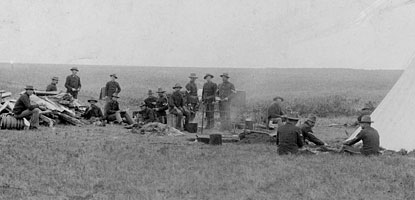Military History
A series of frontier military posts was established in North Dakota and the upper Midwest region of the United States. The purpose was to provide a secure environment for Euro-American settlement and to protect U.S. trading, mining, and transportation interests.
The first military installation in the Pembina region was built in the early 1860s. Euro-American settlers were nervous, fearing attacks by hostile Sioux after the 1862 Minnesota uprising. Many Native American participants from the uprising had escaped to Canada and were living about 60 miles north of Pembina. An urgent appeal for protection was sent to Washington by the Pembina settlers, and a mounted battalion was organized to serve the area.
Three companies and part of a fourth company were recruited in August and September of 1863. Placed under the command of Major Edward A. Hatch, the 300 Minnesota Volunteers became known as “Hatch’s Battalions.”
The battalion reached Pembina on October 6, 1863, and did not complete construction of the post buildings until mid-January 1864. After the capture and surrender of about 400 Native Americans, the post was abandoned at the end of the 1863-64 winter season.
In 1869 Major General Winfield S. Hancock, commander of the Department of the Dakota, recommended the establishment of a post near Pembina. Danger from the Sioux and construction of two railroads were cited as reasons for providing military protection to the area.
On March 24, 1870, the United States Department of War directed the Department of the Dakota to build a post on the Red River near the international boundary. A site was chosen south of the Pembina River and about 200 yards west of the Red River at low water. Because of its altitude, the site had not flooded since 1851, and it provided hay, pasturage, and a good stand of timber.
Fort Pembina reached a maximum garrison strength of 200 men in 1878, but by 1890 there were only 23 men at the post. The average size of the garrison during the fort’s 25-year history was 125 enlisted men and eight officers.
War Department abandonment procedures began in 1891 and came to a dramatic conclusion in 1895 when an incendiary fire leaped out of control and burned most of the buildings. All of the general orders, circulars, and special orders of the post were destroyed except for medical records and post returns. On September 26, 1895, the last detachment of men left the post. Later the reservation (property) was sold through public auction.
Address:
805 State Highway 59,
Pembina, ND 58271
Get Directions
Tuesday After Labor Day–Memorial Weekend Friday:
9 a.m.–5 p.m.
Tues.–Sat.
Memorial Weekend Saturday–Labor Day:
9 a.m.–5 p.m.
Daily
Contact Pembina State Museum:
phone: 701.825.6840
email: shspembina@nd.gov
Contact SHSND:
phone: 701.328.2666
email: history@nd.gov